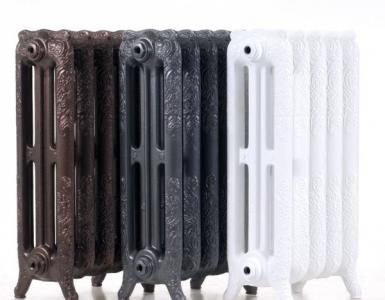How to assemble the summer water supply from the Mon. Make a plan in several projections. Construction of the water supply system with their own hands.
Let's figure out what PND pipes can be used for and how to connect them when assembling various designs.
Areas of use
At once we will specify: we will consider only the fields of application, characteristic for a private house or city apartment. Inside the four walls and nothing else. The use of HDPE pipes in agricultural machinery and drilling of wells is left outside the scope of our attention.
What we know about polyethylene low pressure?
- It is very resistant to mechanical influences;
- Polyethylene is elastic. Elongation at break is six times impressive;
- It begins to soften at a temperature of 80 ° C;
- He is not afraid of aggressive environments: alkalis, acids and bacteria;
- Polyethylene is a dielectric.
If so, everything, except hot water, is subject to it:
- Cold water supply;
- Sewerage;
- Protection of high-voltage cables against water and other external influences.
Installation
Let's start with the simplest.
Sewerage
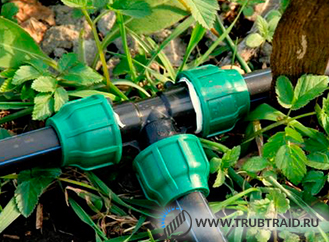
Installation of HDPE pipes with their own hands in the case of sewerage is simple: pipes with tees, couplings and corners are connected using rubber sealing rings; the pipes are inserted into the socket with a small force, if this seal is insufficient, they are smeared with silicone sealant.
Stacking is also not a problem: the wall or ceiling mounts are simple locking latches that are screwed to the wall with screws.
Tip: where aesthetics are unimportant, you can simply drive into holes drilled in the wall steel pins of a slightly larger diameter, bend their ends and lay pipes on these improvised brackets.
Established mounts allow you to mount the pipe only close to the wall, on the pins, it can be laid at a slight distance, which is often more convenient.
Electric installation
HDPE pipes for wiring can equally smooth and corrugated.
Two main features of polyethylene are in demand here:
- Flexibility, elasticity;
- Absence of conductivity.
Pipes for wiring are laid and hidden, inside walls, and on their surface, and used to protect cables when laying in the ground.
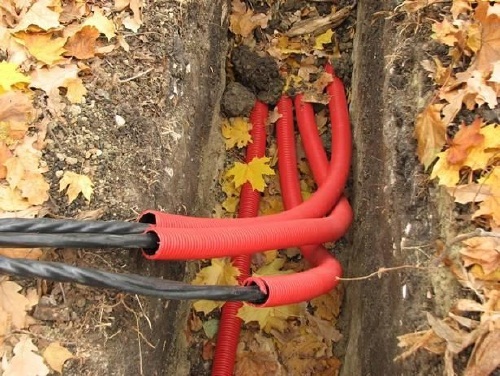
In the latter case, as in the case of use in wet rooms or on the street, the tightness of the pipe joint is important.
It is achieved in one of two ways:
- By butt welding or in couplings;
- Hot casing of the pipe in the socket. The heated pipe is inserted with effort into the socket of the previous one. There it, partially deformed, fills all irregularities of its internal surface, due to which the tightness is ensured.
Water pipes
The most difficult and interesting we left for dessert.
The laying of HDPE pipes inside the building can use several methods. It all depends on the pressure in the water pipe, and on the tools you have, and, of course, on personal preferences.
Compression fittings
The most popular method of installation for small diameter. Compression fittings for pipes up to 110 mm in diameter are produced, but it is practical to use them conveniently up to a 32 mm pipe. However, a larger size inside the premises and not to meet.
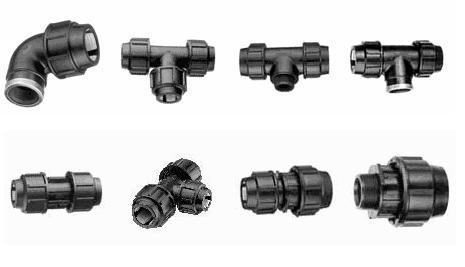
The principle is exactly the same as that of metalloplastikovykh aqueducts, but instead of a split ring a rubber seal is used:
- The end of the pipe is prepared. It is cut at an angle of 90 degrees. Ideally, a special pipe cutter is used for this;
- On the pipe put on the union nut and rubber sealing ring;
- The pipe is inserted into the fitting, after which the union nut is screwed onto its thread.
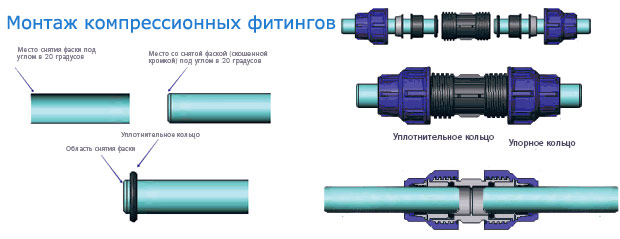
Advantages of this method of installation are obvious: it is extremely simple and makes the connection collapsible. Repair of HDPE pipes with such connections does not require complicated tools: a faulty section of the water pipe is cut out, after which a new pipe is installed in its place on the fittings.
At the same time, we are completely dependent on the quality and durability of the rubber seal. If it becomes unusable, the connection will flow.
Fittings for diffusion welding
And this type of connection seems familiar to us. This is how they connect polypropylene pipes.
Here, the connection of the pipe to the fitting is no different from the installation of polypropylene: we heat the inner surface of the fitting and the outer surface of the pipe on the nozzle of a suitable size iron and insert the pipe into the fitting. After a few seconds, the connection is ready.
![]()
In this case it is already impossible to disassemble the connection. Repair of HDPE pipes, connected by fittings on welding, will again require a special soldering iron to restore the tightness. However, such connections flow when proper installation... Yes, almost never they flow.
Tip: Before assembling such connections, do not forget to remove the chamfer from the outside of the pipe. Scuffs and roughnesses - just what leads to leaks of welded joints.
Butt Welding
Laying pipes HDPE large diameter is always using this method of connection. It is difficult to imagine how the installers during the laying of the trunk drag the soldering iron and put a pipe with a diameter of a little less than a meter into it.
Here the technological operations look different:
- Pipes are centered;
- Between the ends is electric heater;
- After the pipes begin to melt, it is removed;
- After some time, necessary for cooling molten polyethylene, the compound is ready.
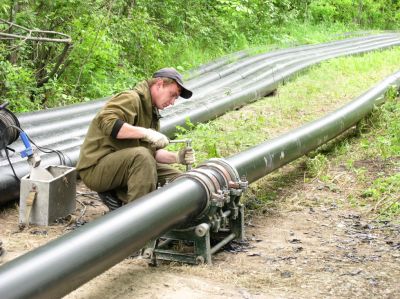
The strength of the butt joint is 80-90 percent of the strength of a monolithic tube. The method is preferably used for pipes with walls not thinner than five millimeters; However, the invention is cunningly tricky: when the need is urgent, HDPE pipes are fused after heating the ends on a simple gas stove. This leaves a grubby seam both outside and inside the pipe; However, such connections are sometimes cold water years.
Aug 5 2015
For normal livelihoods and high-quality irrigation in the suburban area it is necessary to equip the water supply. Previously, cast iron or steel pipeswhich are highly prone to corrosion and have a high weight. Now most masters are more inclined to the idea of conducting a water pipe using low-density polyethylene (HDPE) pipes. And therefore, the best solution will be to use HDPE pipes for water supply in the country, installation of which takes minimum time and does not require special preparation. How to organize summer water supply at the cottage of HDPE pipes? The answer to this question is precisely contained in the article below.
For a start - theory.
If there is no centralized water supply, then the standard autonomous water supply system at the site includes such elements:
- Submersible pump or pumping station, lifting water from a well or well.
- Instruments responsible for the regulation and control of pressure - a relay, a manometer, a hydroaccumulator.
- Protective electrical equipment.
- If the plumbing is fed into the house or summer soul, then there are filters and water heater.
- Pipes.
The value of HDPE pipes
Polyethylene pipes for water supply in the dacha are devoid of the main disadvantages of steel and cast-iron pipes. They do not affect the taste of water, do not rust, are easier to install and are much cheaper. It is for this reason that HDPE pipes have become so popular all over the world.
pros polyethylene pipesrecords:
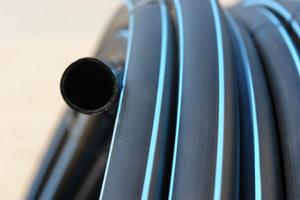
- Extremely long service life.
- Low price. The cost price of these products is small, because they do not require significant financial investments in raw materials and equipment.
- Polyethylene pipes have a very low thermal conductivity.
- Products are not subject to condensation and corrosion.
- A counterweight metal pipes, HDPE products are very plastic.
- These plastic water pipes For a summer residence it is possible to stack both in a trench, and on a surface.
- Drawdown of buildings does not affect the condition of the HDPE pipeline. They can be laid even in regions with high seismic activity and in cold areas.
- Installation of HDPE pipes for water supply in the country can be carried out under any weather conditions.
- Products are not dangerous to the environment and do not emit harmful substances.
- The low weight of the pipes simplifies their transportation and installation.
When we decided on which pipe to use for the water supply in the country, we turn to the practical side of the question.
Tools and materials for installation
Before proceeding with the installation of the water pipe, it is necessary to draw up an individual plan-scheme for a particular section and stock up the necessary tool. The plan will need to take into account the location of the dacha relative to the well, if the latter is outside its limits, and the planned number of water withdrawal end points.
For the installation of pipes for the summer water supply in the country you will need this set:

- HDPE pipes. Their number can be calculated according to the scheme of the water supply. The size is better to choose different: for the basic wiring the diameter of 32 mm is suitable, and for the approach to the points of water intake - 20-25 mm.
- To join the pipes you need different fittings: triple, angled and straight.
- A set of tools for cutting pipes. This should include a metal file, a miter cone knife and a circular saw.
- Special adapters for connecting polyethylene pipes with other elements of the water supply system: watering devices, shower heads, cranes, etc. The diameters of the adapters may be different.
- If the pipes for the suburban water pipe will be dug into the ground, then shovels of various configurations will be needed: for loosening the ground and for raising the soil.
To the note: To ensure that the water pipe has served as much as possible, it is possible to supply it with drainage plastic trays and gratings for covering.
It is quite obvious that for the installation of suburban water pipes from HDPE pipes, expensive materials and a large number of special tools are not required. Part of the above described can be found in every diligent owner in the store, and the rest can be freely bought in the nearest building supermarket.
Mounting technology
After all the preparatory work, you can proceed directly to the installation of pipes for the water supply in the country. All stages must be performed strictly in the following sequence:

That's all. Now you can enjoy the benefits of civilization in a separate dacha section. HDPE pipes will ensure the durability and reliability of the water pipe.
A huge number of advantages of polyethylene pipes (HDPE) allow using them for the implementation of projects for the improvement of private houses and suburban areas. Since they differ enviable strength, ductility and unpretentiousness, they are used for their application when creating water supply lines. Therefore, we will talk about how you can create your own hands.
Materials for water supply
HDPE pipes are products with complex structure, which are an excellent alternative to analogues from other materials. Having been popular for many years, polyethylene materials fully justify their application and cost.
Methods of laying pipes
There are two ways in which you can equip the water supply and provide yourself with communications:

HDPE pipes for water pipes in suburban areas are chosen because their assembly is available to anyone without using expensive equipment. The main thing is that the communication scheme is carefully thought out in advance, and the details for its implementation are interrelated.
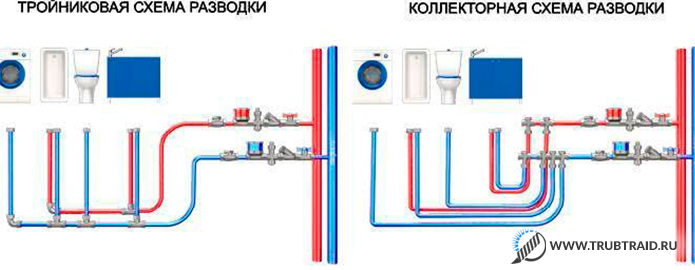
The scheme of connection of a waterpipe in the private house (2 variants).
The process of arrangement of the system in stages
First of all, to bring water, it is necessary to measure the length of the future water pipe from the source (from the well at the dacha) to the point of its entry into the building or other object. This will make it possible to understand what will be the length of the entire highway. Also, collectors for the main line (⌀40 mm) and branches, branch lines (⌀ 20 or 25 mm), as well as fasteners (fittings, couplings, clamps) will still be required.
After the calculations have been made, it will be necessary to determine the version of the arrangement of the system and prepare the necessary tools.
With your own hands, such a project can be realized with the help of butt or electrofusion welding. Thus, a stationary water pipeline with monolithic and hermetic units is installed.
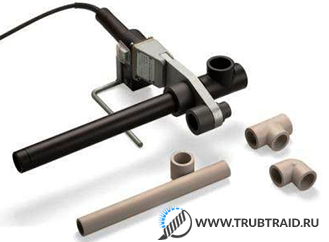 Collectors with internal ⌀ 50 mm and more, it is preferable to join the butt by means of a special apparatus for HDPE materials (it melts the ends of the pipes that join and form an integral structure). The second is used for collectors with a smaller inner diameter or in cases where several nodes are planned on the water supply line.
Collectors with internal ⌀ 50 mm and more, it is preferable to join the butt by means of a special apparatus for HDPE materials (it melts the ends of the pipes that join and form an integral structure). The second is used for collectors with a smaller inner diameter or in cases where several nodes are planned on the water supply line.
In any case, whichever method of assembly you choose, will ensure the reliability and durability of the operated communications only compliance with all installation rules.
Below is a cognitive video on how to choose the right polyethylene pipe:
When leaving for a summer residence outside the city, few people are ready to completely abandon the benefits of civilization, especially when it comes to running water. And if there is still not there - it does not matter. There is nothing difficult in constructing a water pipe in the country house with their own hands without any problems. You only need to find the source of water intake, determine the type of system, pick up materials and tools and consistently follow all instructions.
The construction of any water pipe begins with the choice of the source of water supply. Although the choice is usually not great. It can be a centralized water supply system, a well or a well. From where the water comes from, it depends not only on its quality, but also on the structure of the entire plumbing system, its complexity and cost.
How to make a water supply from a well
The simplest "grandfather" method is to dig a well. Its depth depends on the occurrence of the aquifer - up to 10-20 meters, as a rule. Of course, you can use this water only if filters are installed. Water in wells is often contaminated with nitrates and heavy metals.
The well must necessarily be insulated. Do this to a depth that exceeds the mark of seasonal freezing in the region by 20 cm. A foam is used, which covers the entire aboveground part of it. The pipe that connects the well to the pumping equipment (+)
In addition, the well is often unable to provide drinking water to the water, and its capacity is usually about 250 liters per hour. This amount is sufficient for use in domestic needs, but for abundant watering a large area or filling the pool this may be small.
Water well - what are the advantages
The best option is a well. There is no way to do without special equipment - do not drill a well with a shovel. The main advantage of such a source of water supply is the purity of water. The depth of the well for a private house starts from 15 m. With such depth of occurrence, water is not contaminated with nitrate fertilizers, domestic sewage and other agricultural waste.
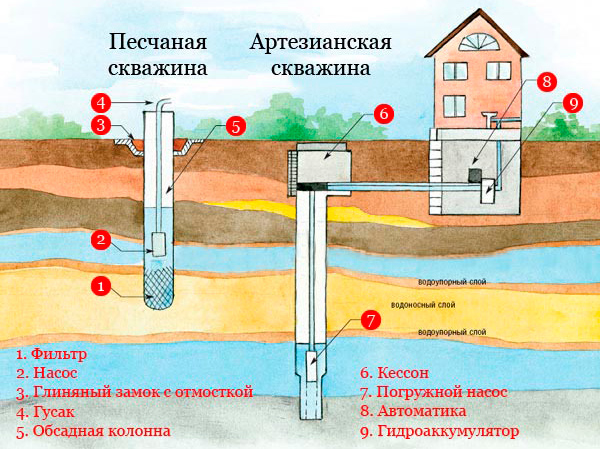
It is important to take into account the presence of iron or hydrogen sulfide in the water. If such impurities are present, water can only be used if there is good filtration (+)
Drilling a well will cost much more than digging a well, and it is not easy to maintain it: constant cleaning, prevention, washing. But 1.5 cubic meters per hour, which can be lifted from the well, provide almost unlimited consumption of clean and fresh water.
How to connect to the central pipeline
If you have a central water supply near your site, you can connect to it. Among the advantages of this option is a constant head and water purification. However, in practice, the pressure often does not correspond to the norms, and there is nothing to talk about cleaning.
In addition, just connect to the pipeline you will not get out - it's illegal. We'll have to write an application to the water canal, provide the site plan with all communications, draw up project documentation and get permission to the Sanitary and Epidemiological Station. The whole procedure is stretched for several months and flies in penny.
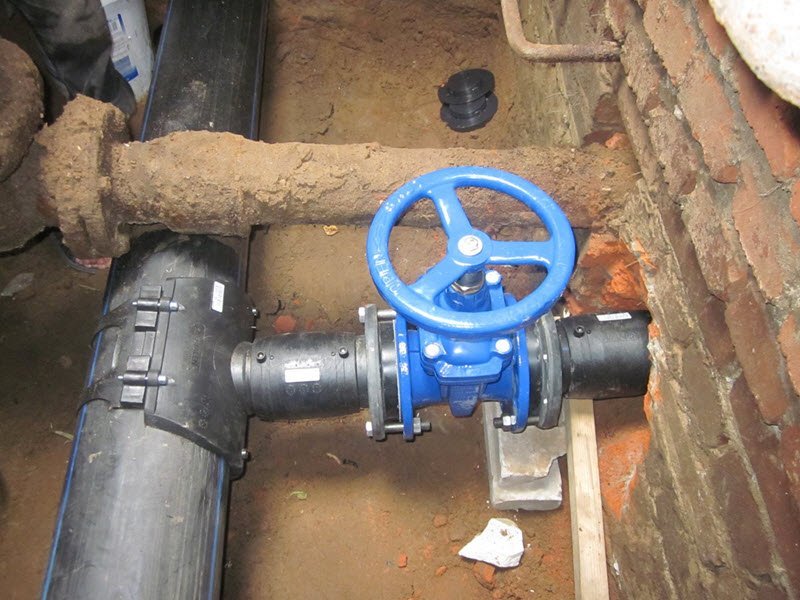
Connect your site to the central water supply must the plumber from the water canal, which has permission for such work. Unauthorized use of water is prohibited.
It is also impossible to use such water uncontrolled, for each used cubic meter it is necessary to pay at the established tariff. Based on all of the above, not only many summer residents, but also residents of private households make their choice in favor of drilling a well on their site.
Winter or summer - how to decide
Depending on how often you come to the dacha, the plumbing scheme that suits you may be:
- all-weather (winter);
- simplified (summer).
If your site is used exclusively in the summer season, that is, from spring to autumn, it is simply not worthwhile to spend money on an expensive water main. In this case, there may be two options - a collapsible water supply and a stationary one.

After the end of the summer season, the hoses of the demountable water pipe are removed, leaving only the points of draw-off. Next year you can connect to them again
The first is very convenient because at the end of the season all the hoses can be removed and stored. So they will not spoil from the cold and will last longer. For laying such a water pipe, you do not even have to use a shovel - all communications run on the surface.
A little work will have to be done when laying a summer water pipeline of stationary type. It also does not presuppose the availability and installation of complex equipment, but differs in that the pipes are underground and are not removed for the winter. In the right places take out collapsible cranes. The main condition is to completely drain the water from the system for the winter, so that, at minus temperature, the frozen water does not break the pipes.
The summer water supply will be quite sufficient for elementary household and agricultural needs in the scale of a summer cottage site. But if you are accustomed to comfort, use the dacha as a place to rest and want to use water the same way as at home in the city, then it is better to make a winter version of the water pipe in the country.
Winter water supply system is much more complicated. Everything must be taken into account natural bias terrain to the depth of freezing of the ground. It is necessary to have a pump to ensure the pressure of water. In a word, the winter type water supply system is no different from the water supply system of residential private houses.
What does the water supply system consist of?
The water supply in the villa area consists of several elements:
- pump equipment;
- pipes and fittings;
- pressure switch and manometer;
- accumulator;
- a device for draining;
- expansion tank.
In addition to the above, the system can include other elements, such as filters or heaters, some of the components can be combined in one complex, for example, a pumping station.
Raise water from the well - select the pump
The water from the well or well is supplied by a pump. The choice of the pump is one of the main tasks when planning the water supply of the suburban area. The choice of pump depends on:
- depth of well or well;
- volume of consumption;
- the productivity of the well itself (debit);
- diameter of the well;
- water pressure;
- financial component.
Some of these parameters can not be calculated accurately, an approximate estimate is made. To do this, it is better to consult an experienced master so as not to make mistakes. There are two types of pumps:
- submersible;
- surface.
Surface version is used only for pumping water from the well. It can be placed on the surface or inside the well, but stay afloat. The maximum depth for which a surface pump is suitable is 8 m. If your well is deeper or it is a well, then this type of pumps is not considered.

The pump station combines several elements: a hydraulic accumulator, a manometer, a pressure switch and the pump itself
For wells, choose submersible pumps that are not afraid of water. Their advantages include low energy costs and quiet operation with a high level of performance. There are 2 types submersible pumps, depending on the type of action:
- centrifugal;
- vibratory.
Centrifugal pumps pump fluid with the help of blades. Under the action of the centrifugal force, which arises as a result of the rotation of the blades, water enters the pipeline and moves along it. Centrifugal models are very popular due to their reliability, high productivity and reasonable price.
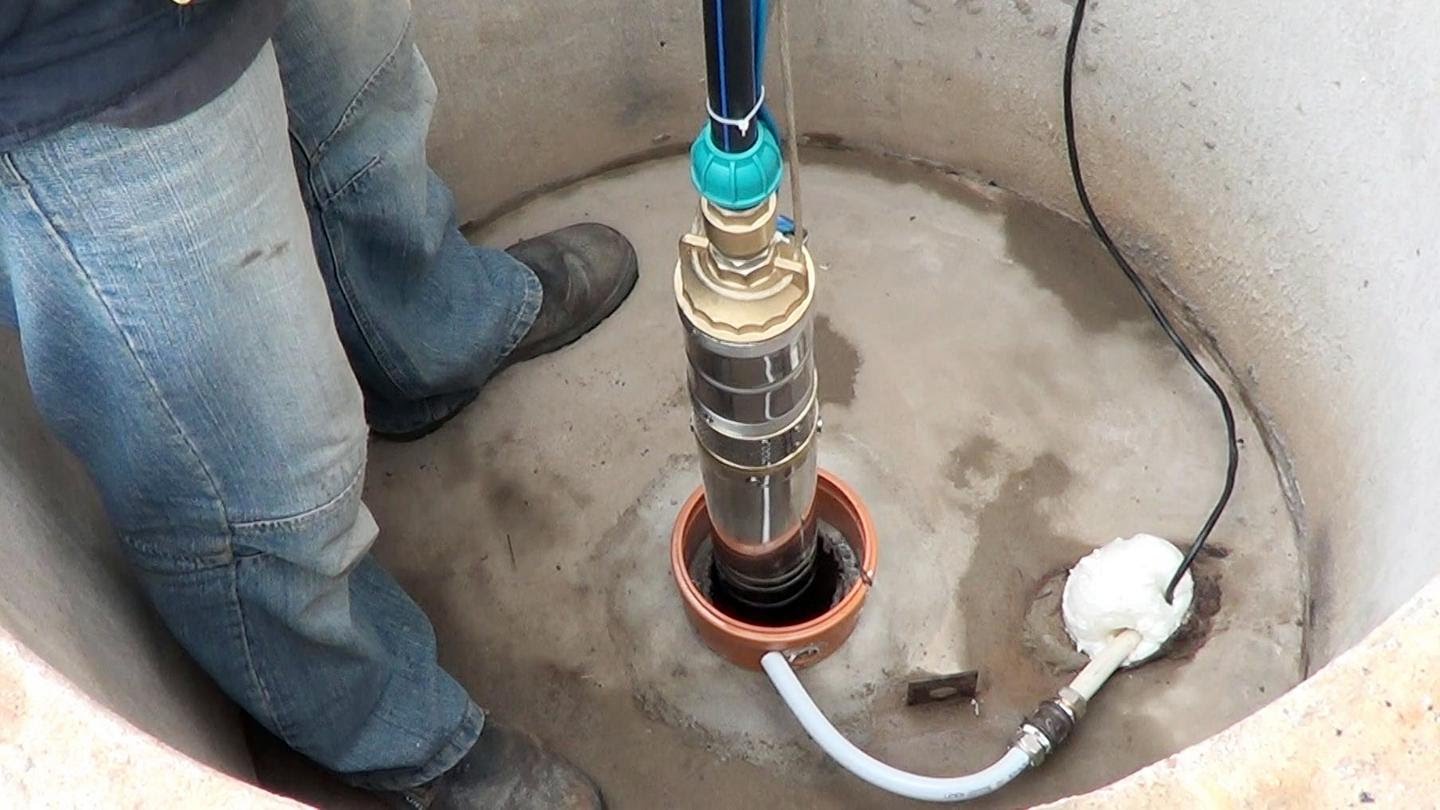
Submersible pump has the form of a narrow long capsule. It is placed in a well, in the water column at the depth declared by the manufacturer
Vibration pumps have a fine-pored membrane in their structure. The liquid is pumped as a result of the pressure difference arising from the deformation of the membrane. Such a pump requires more thorough maintenance, the membrane can become dirty and fail. Eliminate such a breakdown is possible, but repair or replacement will be expensive.
Which pipes are suitable for suburban water supply
Water is supplied to the house and for household needs through a pipeline. The most commonly used pipes are 1 or 3/4 inch in diameter. Of the modern materials for suburban water supply suitable:
- polypropylene;
- polyethylene pipes.
Each of the varieties has its pluses and minuses. So, polypropylene pipes are more expensive than polyethylene pipes. To connect them you need to get a special tool - a soldering iron or welding machine for pipes. But on the other hand, the soldering iron can also not be bought, but rented for the time of installation, but the savings on the connecting fittings are significant, especially if the pipeline scheme involves many branchings.
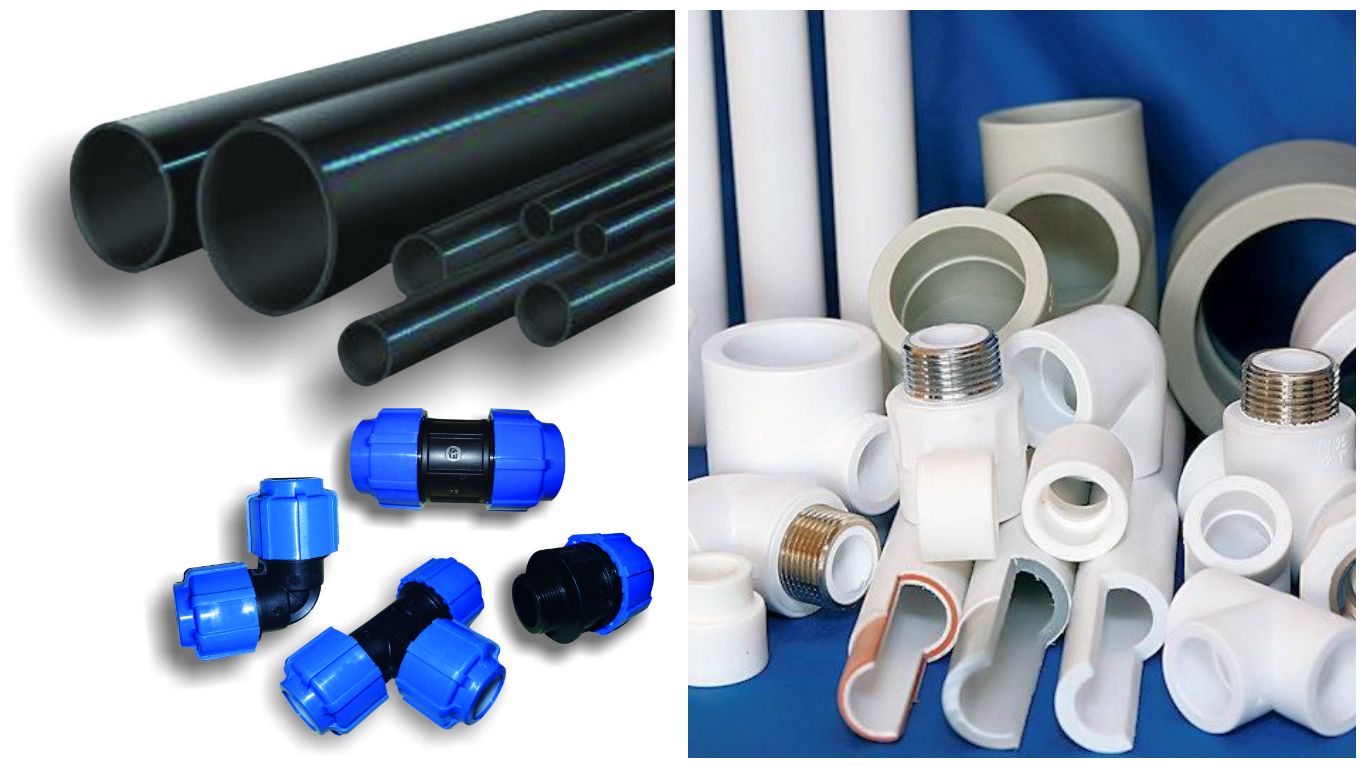
And polyethylene pipes high pressure, and polypropylene pipes perfectly cope with their task. They are not subject to corrosion
Polyethylene pipes are cheaper, but to connect them you need to buy metal elements, which in sum are more expensive than the whole pipeline. And to guarantee completely sealed connection, as when working with soldering iron and polypropylene pipe, it is impossible. Joints - weak point of polyethylene water supply.
To ensure that the winter water supply does not suffer from low temperatures and does not freeze, care should be taken to insulate the pipeline. A modern solution - special tubular "cases" made of foamed polypropylene. This simple solution can protect your pipes from freezing and cracking.

The insulation is sold in different diameters, according to the diameter of the plastic pipes. It must be worn before connecting pipes
Another option for warming is the heating cable. It is laid parallel to the pipeline along its entire length. In the cold season, the cable warms the pipes and prevents frost. But, of course, there are electricity costs to ensure constant heating.
Demountable and shut-off valves
The drainage armature is also of great importance. The reliability of the whole system depends on its quality. In the country kitchen, bathroom or bath you can install ordinary mixers, but they will not fit for installation outdoors. Outside, it is better to mount much more reliable and practical cranes with grand-bugs or bronze latches.
The input dispenser is located on the surface, for example, in the utility room or in a specially designated place in the house. It includes a complex of valves that cut off various branchings of the system, a device for measuring, controlling and controlling pressure.
Monitoring system pressure
For comfortable use, the pressure in the system must be constant. The normal value is from 2.5 to 4 atmospheres. Do not allow too low or too high rates. To monitor this parameter, the system is equipped with a special complex - a pressure switch and a hydraulic accumulator.
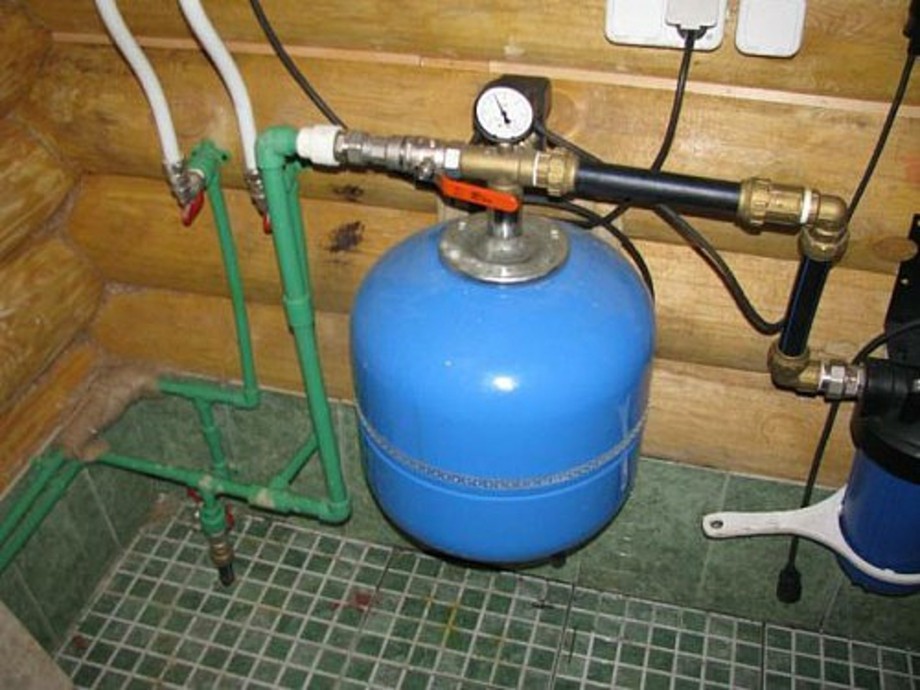
Such a system will protect the water pipeline from a water hammer if the pressure rises sharply. If the system is significantly exceeded, the system will turn off
The accumulator is a tank that is filled with water from the system. Behind the tank set the relay. This device measures the water pressure in the system. When it reaches the maximum permissible level, the pump shuts down and the water continues to flow from the battery capacity. When the pressure is stabilized, the relay again starts the pump and fills the tank.
Another important device for the competent installation of a water pipe in the country is a sensor for lack of water - a dry relay. It will shut down the system when in the well for some reason there will be too little water and prevent overheating and breakage of the pump.
Water expansion tank
The head in the system of the suburban water supply is provided by means of a water tank. Its role, as a rule, is performed by a plastic barrel of large volume, located on a raised platform. If there is a place in the attic - it is placed there. If instead of an attic you have a mansard floor, a water tank can be placed on a specially constructed tower or flyover.
If the tank is located in an unheated room, and periodic residence in the country in winter is planned, then you should take care of its insulation separately. This can be a protective construction, insulated with foam or mineral wool. The main thing - to carefully monitor that the tank was sealed. Otherwise, the insulation particles, as well as dust and debris can get inside and contaminate drinking water.
Drain valve for system conservation
There are situations when the water supply system has to be preserved, for example, during a long time of departure or repair. In such cases, all water must be drained from the system. To do this, immediately after the pump, that is, at the lowest point of the system, drain valve.
If you turn off the pump and open the valve, the water will begin to move in the opposite direction through the pipeline due to the gradient. Sometimes they act in a different way and establish check valve and bypass piping - bypass. This scheme is used when using water from deep wells and wells.
How to arrange sewage for water disposal
Since there is practically no central sewer in the country cottages, care must be taken for an individual solution for draining sewage and liquid household waste. In the old manner, you can dig a cesspool, but this does not correspond to sanitary norms. Yes, and clean such a pit will often.
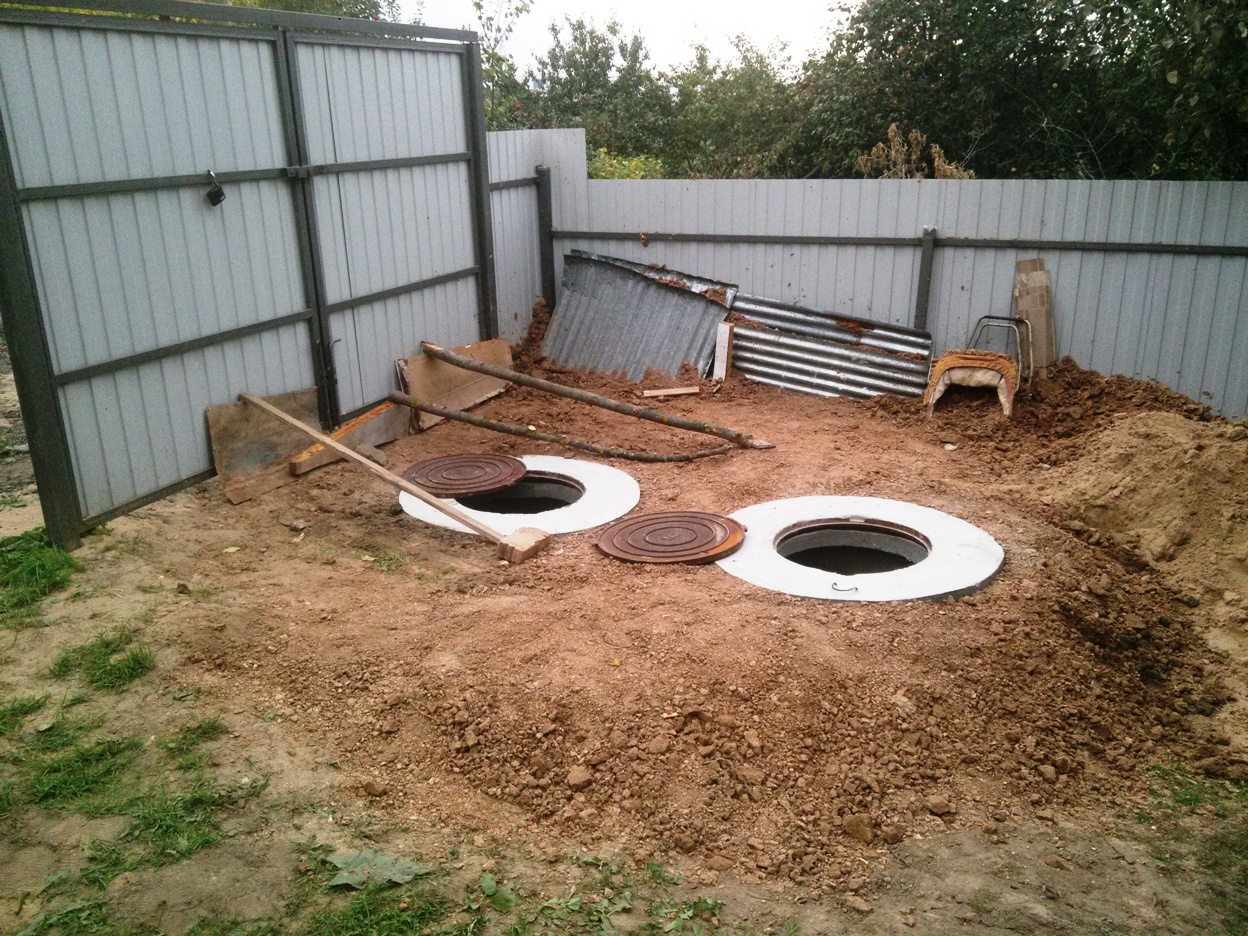
In the construction of the septic tank, the principle of sewage treatment in several stages is laid. In order for the septic tank to work correctly, all the chambers, except the extreme one, must be completely sealed
A modern solution is the septic device. The simplest and most common method is a septic tank of 2-3 concrete rings. Although there are more advanced technologies, such as the eurocube, for example. The task of the septic tank is to separate the solid component of the effluent, and the relatively pure liquid, to drain it back into the soil. Thanks to this system, you can do with one call of the sanitizer in a few years.
Step-by-Step Installation Guide
In order for the dacha to build a water pipeline on its own, it is necessary to make preparatory work: draw up a plan, prepare tools and materials. Only after careful preparation can begin to lay the pipeline, connect and install internal wiring.
Make a plan in several projections
Begin the work with a detailed plan. If the scheme is planned to be complex, the professional can not do without the help of a professional, because water supply is a responsible business. If you decide to do it on your own, prepare all the information:
- depth of soil freezing in your region;
- depth of groundwater;
- inclination of the relief;
- the plan of existing communications with indication of water withdrawal points;
- site plan with all buildings;
- the number of points of consumption (water supply at home, baths, watering the garden, filling the pool, etc.).
First, draw detailed scheme in scale. In addition to the usual plan of the terrain, draw a profile image of the pipeline and the plan in isometric view. So you can take into account the slope when laying a water pipe in the country. In the presence of such a drawing, it is not difficult to calculate the number of pipes and fittings. Never buy material back-end, make a small margin - about 10% of the total.
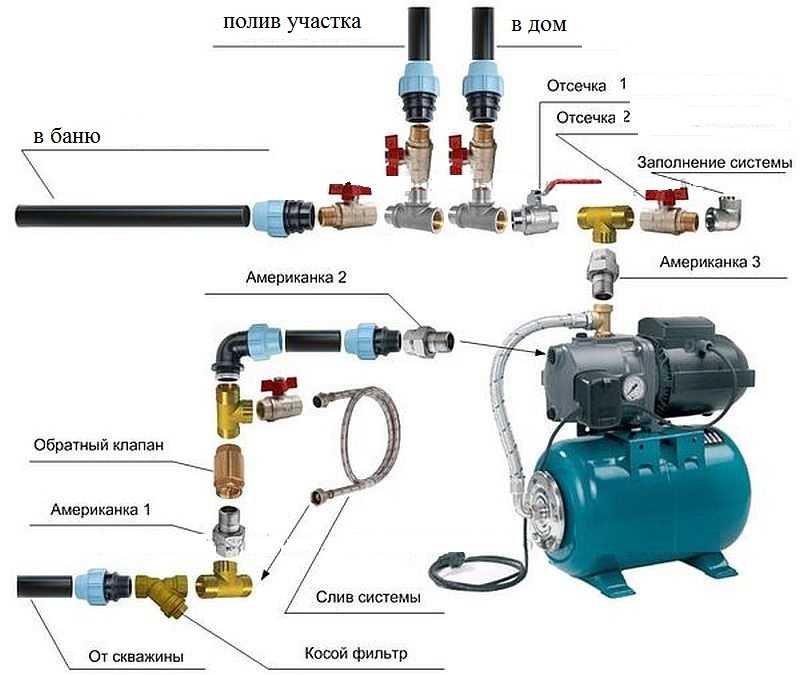
It is necessary to detail all the connecting elements and fittings to be used. So you not only will not forget to buy anything, but you will not make any mistakes during installation (+)
The depth of freezing is one of the most important characteristics. It depends on it how deep the pipes will be laid. Note that the depth of the pipe laying should be greater than the freezing depth of the soil by at least 20 cm at the lowest point of the site.
Required tool kit
When the scheme is ready, the materials are counted, you need to take care of necessary tools. Suppose that you already have a well or well, so you can skip the stage of their device.
Mounting Tools winter water supply in the country:
- shovel;
- adjustable wrench;
- gas key;
- welding machine for pipes - "iron" (when using polypropylene);
- roulette;
- pipe cutter;
- hacksaw;
- gun for silicone and sealant.
Such a set will be sufficient for conducting earthwork and plumbing works.

You can buy a ready-made set of plumbing, which includes all the basic tools for laying water. But measuring instruments still have to be bought separately and it is better not to save on quality
If electric installation work you plan to do it yourself, then you need to expand the set of tools with a screwdriver, tester, nippers and other electrician tools.
Algorithm of actions in order
To properly organize the work, you need to step by step to consider how to make a water main in the country:
- Excavation. Armed with a shovel, engage in trenching along the entire length of the water pipe according to the plan;
- Take care of feeding the pump. It is necessary to dig a separate trench, lay an electric cable and mount a socket for connecting the pump;
- Install the pump. Depending on its type, it can be located outside or immersed in a well;
- Connect the pressure switch, pressure gauge and accumulator to the pump. Then securely attach the pipe leading to the points of consumption;
- Install a drain valve for possible system conservation;
- Mount the piping system along the bottom of the trench. Do not forget about the insulation of the pipes at this stage;
- Bring out the external pumping points;
- Connect the system and check its operability. Special attention is given to joints of pipes, and also to places of connection of equipment;
- If the system works stably and there are no leaks, the trench can be buried and proceed with the installation of the internal water distribution system;
- Plastic pipes do not rust, so they can be deepened inside the walls. Install all faucets, plumbing, filtration systems and water heaters.
Water from the well must be cleaned. It is best to do this with flow filters or systems reverse osmosis. The latter provide complete purification from all impurities at the molecular level, but the cost of their installation and maintenance is an order of magnitude higher.
Heating tap water at the cottage
For water heating in the country, water heaters of flow type (gas or electric) and storage type (boiler) can be used.
Gas columns are very convenient, water is heated in unlimited quantities, quickly and qualitatively. And you can save on electricity. But, firstly, the gas pipeline at the dacha is a rare phenomenon, and a gas cylinder connect the column does not make sense, and secondly, the installation of the column should be done only by a qualified gas man.
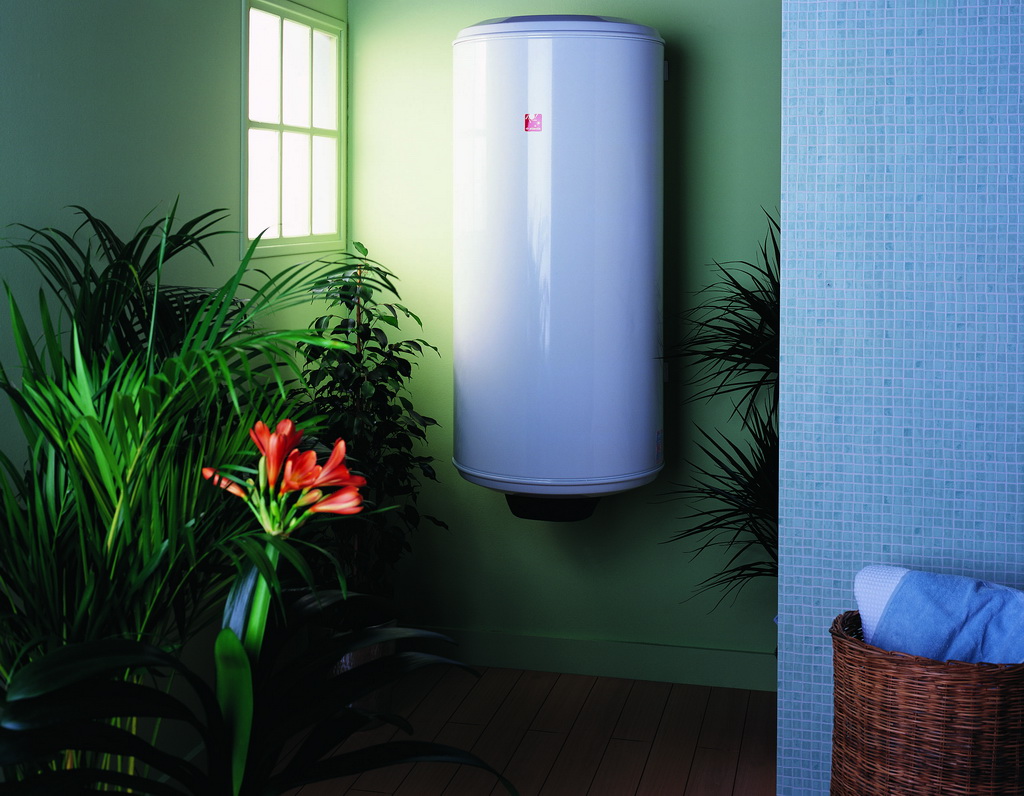
The volume of the boiler depends on the number of people who will use hot water. If you only wash your hands or dishes, 50 liters of the unit will be enough, but in order to take a shower, you need to install at least 80 liters of tank
Electric heaters can be installed and dismantled at any time, this is their advantage. However, according to the heating rate, they are inferior to gas flow columns. Electric boiler - the best option for use in the country. Hot water always available, it is inexpensive and can install any novice master.
Video instructions for laying the pipeline
In order to understand how to lay the water pipe in the country, look at these visual video-manuals. They detail how to install a water pipe from a well, a water well, and how to make a summer water supply option at a summer residence.
Video review of the laying of the aqueduct with surface pump from the well:
Instructions for the installation of summer water supply of summer type:
And this is the instruction for connecting all equipment - pressure switch, dry run relay, etc .:
If you stick to all our recommendations, you can lay the water pipe in your dacha without involving professionals.
Buying desired country cottage area, a good owner first of all will start to equip the water supply system and this will be true. Summer water supply in the country house with their own hands is not so difficult. After all, without life-giving moisture, you not only can not grow a normal crop, but any construction will be very difficult.
Even if you bring quickly installed dacha houses from a block of containers, they will need some small foundation, which requires water to equip. Rent a diesel generator for a dacha, for some time solve the problem of energy supply, but without the water of joy from this will be few.
Where to get water from
Traditional sources of moisture intake there are several, which one is preferable for your site to decide strictly individually. We, in turn, will tell you about the most common.
Tip: if there is such an opportunity, it is better to begin drafting the project with a survey of the nearest neighbors. Taking advantage of their experience and taking into account their mistakes can avoid significant costs.
Good old well
If in your locality the depth of the aquifer is high drinking water is within 3 - 15m, then do not reinvent the wheel. Well will be the best solution for you.
The cost of equipping the medium well will not be much higher than drilling a well on sand. If the site does not stand on rock, then 2 - 3 people can dig a well in 1 - 2 weeks.
It is most convenient to do this with the help of concrete rings, the first ring is installed in the foundation pit and the soil is selected from under it. As the depth is deepened, the structure is built up.
Important: unlike the well, the life of the wells fluctuates around 50 years. Plus, when power is cut off, water from the well can be raised by a bucket.
Drilling wells
There are 2 types of wells, sand and artesian. The depth of occurrence of the well on the sand, depending on the location, varies between 10 and 50 m. The horizon can begin immediately after the first layers of dense loam. This same loam acts as a natural filter, cleansing ground and thawed waters.
The water reserve depends on the thickness of the reservoir, but on average from such a well it can get up to 500 liters per day. A serious problem here may be sand or silt contamination of submersible pumps and filtration systems.
Such structures usually live not for long, about 5 to 20 years. But if you get to a deep underground river and qualitatively equip a wellbore, then such a source can serve longer.
Experts advise drilling such wells manually, and to search for a place for drilling better using grandfather methods. According to experience, with this approach, the probability of finding a quality source increases many times. With machine drilling, you can just skip the desired horizon.
Water in artesian wells is extracted from the limestone horizon. It is certainly more rigid, but it differs with exceptional purity. The depth of occurrence here is not predictable.
In rock formations you can stumble on an underground lake already on 30 - 40 meters. But there is an option to drill and more than 100 meters.
Arrangement of such wells is quite expensive and, as a rule, they are made into a fold. In addition to serious financial investments, you still need official permission from the authorities, because artesian water, this is the property of the state. But there is a high probability of securing yourself clean water in the next 50 years.
Alternative methods
A simple and relatively reliable option is to connect to an already completed highway. Now it can be done directly under pressure. To do this, use an overlaid tee with a ball valve.
The tee is fastened with bolts to the line, after which a hole is drilled in the pipe and the valve closes quickly. Next, you can mount the branch.
Alternatively, you can use water from natural reservoirs nearby, but no one will give you a guarantee of cleanliness. Therefore, such water is more suitable for irrigation. It is also possible to collect rainwater in separate reservoirs, but of course there are no serious scales here.
Ways of equipping the water supply system
For irrigation and some domestic needs, you can mount a temporary or stationary system year water supply.
Demountable construction
Collapsible version of the system is assembled from flexible silicone or rubber hoses. They are connected by metal or plastic adapters and connectors. Such fittings are not expensive, plus it's easy to make by yourself.
Speaking of the merits, it should be noted that the price of such a design will not be high, plus it can be collected in a couple of hours. Any damage here can be quickly found and eliminated.
But such a system is very vulnerable. Pipes in it, as a rule, lie directly on the ground or are mounted above the ground on special suspensions, so they can easily be damaged.
At the end of the season, it will need to be disassembled and hidden, since there is a possibility of theft. Experienced summer residents know that the most unpleasant thing here is that all these hoses will all cling to.
Tip: for the installation of a temporary structure, experienced summer residents lay a collapsible highway from HDPE pipes. It passes through the center of the site and is equipped with several nodes for connecting flexible silicone hoses. Such a system is much simpler and more practical, plus a flexible hose is required much less.
Stationary summer system
Stationary water supply is certainly more convenient than a demountable one, since it is laid underground, it will not interfere and spoil the landscape of the site. Do not be confused by the word stationary, the price of such a design will not be much higher than that of a temporary system. Of course, it will be necessary to tinker with the arrangement, but believe me, it's worth it.
The big plus is that the correctly laid central highway system can, if necessary, become the basis for the arrangement of a winter water pipe in the house.
- As in any case, you should start by creating a project. Here, the more you carefully and scrupulously write and draw each node and sector of the system, the easier it will be to select equipment, materials and perform installation.
- According to experience, we can say that it is better to draw a sketch directly on the terrain, that is, independently pass each meter and turn the main line. So it will be easier to calculate the number of connectors and determine how many connection points you need.
- The central trunkline and branch bends can be made from polypropylene pipes or from low-pressure polyethylene pipes of HDPE. In terms of costs, these systems are approximately equal, the fact is that polypropylene pipes are more expensive than HDPE, but the price of couplings and connectors for HDPE equals the cost of the estimate.
- Also, please note that polypropylene pipes are soldered, therefore, you need a power source. The design of HDPE pipes can be assembled without soldering.
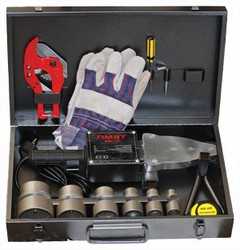
- If the total length of the system does not exceed 30 m, then 20 mm diameter pipes are sufficient for its installation. But experts advise to lay the central pipeline with pipes 25 mm in diameter, and wiring by sectors can already be done with 20 mm pipes. For a low-pressure system, it is better to use pipes with a cross section of 25 mm.
- Assembly instruction standard. All pipes should be placed taking into account that for the winter the water from the system must be drained. That is, the entire system should go downhill and at the lowest point a valve or valve should be installed to drain the system. The lower point is in the water intake area.
- If you mount the system for, then the depth of the bookmark is made in the area of 20 - 30 cm. To water the beds, the pipe must be buried to a depth of the order of half a meter, so as not to damage it when digging with a shovel or cultivator.
- For the installation of a structure from HDPE pipes, special couplings with internal and external threads. Although they already have sealing rings, it is desirable to rewind the fum-tape on the thread, it is wound clockwise without wrinkles, 6-8 turns. This at times will increase the density and hence the longevity of the joint.
- As a rule, the central highway is laid from the water intake to the house and conclusions are drawn from it for connecting a flexible hose or wiring by sector. It makes sense to make it more thorough, so that there is an opportunity to bring water into the house, if, for example, you decide to meet the new year at the dacha.
- Many experts advise that the pipe does not freeze, lay it deeper than the freezing level of the ground. But in some areas of our homeland the freezing level reaches 1.5 m and it is rather difficult to do this. It is much easier to bury the pipe to a depth of 30 - 50 cm and warm it.
- For insulation, at the bottom of the trench is laid a bed of technical polyethylene, you can take a cut plastic pipe large diameter. As a heat-insulating filler, any non-hygroscopic porous material, such as foam plastic, slag or expanded clay, can be used.
- On the main pipe is attached a special wire. When connected to the mains, it will heat up and prevent the line from freezing during operation, pipes with built-in heating thread are produced, but they are expensive.
- The pipe is laid on the heater and topped with the same layer of insulation. After that, the entire structure is closed with waterproofing and filled with soil.
- When selecting a pump, note that the passport indicates from what depth it can lift water. So to the real depth of your well or well, you need to add the length of the irrigation distribution system at a rate of 1m vertical lift.
Valves on the tuba.
Advice: when purchasing a coupling for connecting an aquapistol or other sprinkler, it is better to take the so-called coupler with an aquastope, the valve is mounted in it, due to which when the device is replaced it is not necessary to turn off the water.
Advice: cranes and latches for connection in a house or a greenhouse are better to take cast iron, brass or bronze. Ball valves made of composite materials do not last long.
The video in this article shows some of the subtleties of installing a water pipe.
Conclusion
We talked about the basic principles of equipping the simplest water supply. But progress does not stand still and if the means allow such a system to be equipped with an automatic system that will regulate the time and quantity of the supply of life-giving moisture. There are no limits to perfection.




